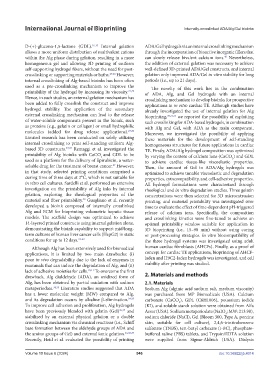Page 554 - IJB-10-6
P. 554
International Journal of Bioprinting Internally-crosslinked ADA/Alg/Gel bioinks
D-(+)-glucono-1,5-lactone (GDL). 16,18 Internal gelation ADA/Gel hydrogels via an internal crosslinking mechanism
allows a more uniform distribution of multivalent cations through the incorporation of bioactive inorganic fillers that
within the Alg phase during gelation, resulting in a more can slowly release bivalent calcium ions. Nevertheless,
40
homogeneous gel and allowing 3D printing of uniform the addition of external gelation was necessary to achieve
self-supporting hydrogel fibers, without the need for post- well-defined 3D-printed ADA/Gel constructs, and internal
crosslinking or supporting materials or baths. 27,28 However, gelation only improved ADA/Gel in vitro stability for long
internal crosslinking of Alg-based bioinks has been often periods (i.e., up to 21 days).
used as a pre-crosslinking mechanism to improve the The novelty of this work lies in the combination
printability of the hydrogel by increasing its viscosity. 22,29 of ADA, Alg, and Gel hydrogels with an internal
Hence, in such studies, an external gelation mechanism has crosslinking mechanism to develop bioinks for prospective
been added to fully crosslink the construct and improve applications in in vitro cardiac TE. Although studies have
hydrogel stability. The application of the secondary already investigated the use of internal gelation for Alg
external crosslinking mechanism can lead to the release bioprinting, 28,32,33 we reported the possibility of exploiting
of water-soluble components present in the bioink, such such crosslinking for ADA-based hydrogels, in combination
as proteins (e.g., gelatin or collagen) or small hydrophilic with Alg and Gel, with ADA as the main component.
molecules (added for drug release applications). 27,30 Moreover, we investigated the possibility of applying
Limited research has been conducted on solely utilizing these materials for the development of self-standing
internal crosslinking to print self-standing uniform Alg- homogeneous structures for future applications in cardiac
based 3D constructs. 27,28 Remaggi et al. investigated the TE. Firstly, ADA/Alg hydrogel composition was optimized
printability of Alg bioinks with CaCO and GDL to be by varying the content of calcium ions (CaCO ) and GDL
3
3
used as a platform for the delivery of Epirubicin, a water- to achieve cardiac tissue-like viscoelastic properties.
soluble drug for the treatment of breast cancer. However, Then, the amount of Gel in ADA/Alg hydrogels was
27
in that study, selected printing conditions comprised a optimized to achieve tunable viscoelastic and degradation
curing time of three days at 2°C, which is not suitable for properties, cytocompatibility, and cell-adhesive properties.
in vitro cell cultures. Sardelli et al. performed an extensive All hydrogel formulations were characterized through
investigation on the printability of Alg inks by internal rheological and in vitro degradation studies. Three gelatin
gelation, exploring the rheological properties of the concentrations were then selected for 3D microextrusion
material and fiber printability. Guagliano et al. recently printing, and material printability was investigated over
28
developed a bioink composed of internally crosslinked time to evaluate the effect of time-dependent pH-triggered
Alg and ECM for bioprinting volumetric hepatic tissue release of calcium ions. Specifically, the composition
models. The scaffold design was optimized to achieve and crosslinking kinetics were fine-tuned to achieve an
14-layered printed constructs using internal gelation alone, optimal printability window suitable for application in
demonstrating the bioink capability to support mid/long- 3D bioprinting (i.e., 15–90 min) without using curing
term cultures of human liver cancer cells (HepG2) in static or post-processing strategies. In vitro biocompatibility of
conditions for up to 12 days. 31-33 the three hydrogel systems was investigated using adult
Although Alg has been extensively used for biomedical human cardiac fibroblasts (AHCFs). Finally, as a proof of
applications, it is limited by two main drawbacks: (i) concept for cardiac TE applications, bioprinting of AHCF-
poor in vivo degradability due to the lack of enzymes in laden and H9C2-laden hydrogels was investigated, and cell
mammals that can induce the degradation of Alg, and (ii) viability after printing was studied.
lack of adhesive moieties for cells. 10,11 To overcome the first
drawback, Alg dialdehyde (ADA), an oxidized form of 2. Materials and methods
Alg, has been obtained by partial oxidation with sodium 2.1. Materials
metaperiodate. 34,35 Literature studies suggested that ADA Sodium Alg (alginic acid sodium salt, medium viscosity)
has a lower molecular weight (MW) compared to Alg, was purchased from MP Biomedicals (USA). Calcium
and its degradation occurs by alkaline β-elimination. 34,35 carbonate (CaCO ), GDL (C6H1006), potassium iodide
3
To improve cell adhesion and proliferation, Alg hydrogels (KI), and soluble starch solution were obtained from Alfa
have been previously blended with gelatin (Gel) 36,37 and Aesar (USA). Sodium metaperiodate (NaIO ; MW: 213.98),
4
stabilized by an external physical gelation or a double sodium chloride (NaCl), Gel (Bloom 300, Type A, porcine
crosslinking mechanism via chemical reactions (i.e., Schiff skin, suitable for cell culture), 2,4,6-trinitrobenzene
base formation between the aldehyde groups of ADA and sulfonate (TNBS), tert-butyl carbazate (t-BC), phosphate-
the amino groups of Gel) and external ionic gelation. 36,38,39 buffered saline (PBS) tablets, and Trypsin/EDTA solution
Recently, Heid et al. evaluated the possibility of printing were supplied from Sigma-Aldrich (USA). Dialysis
Volume 10 Issue 6 (2024) 546 doi: 10.36922/ijb.4014

